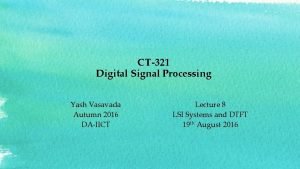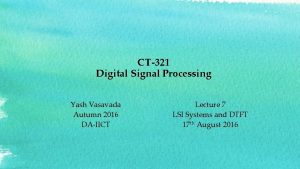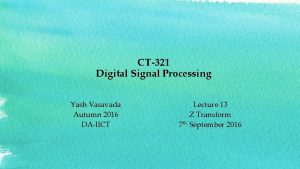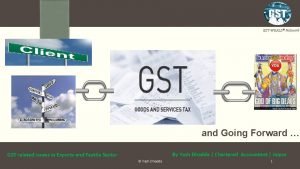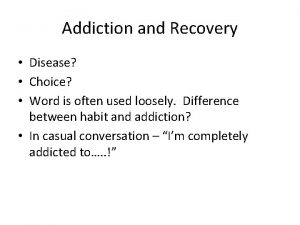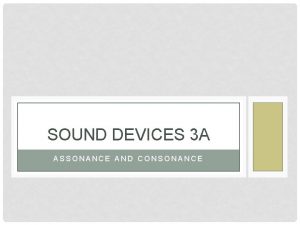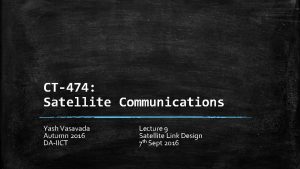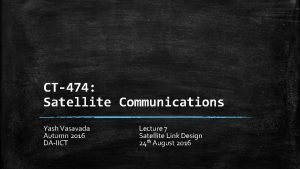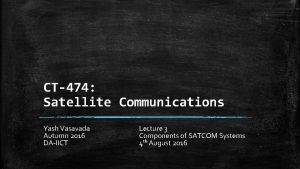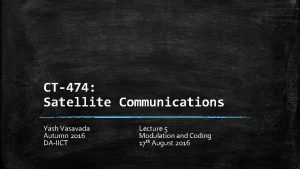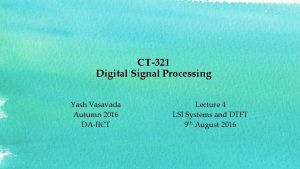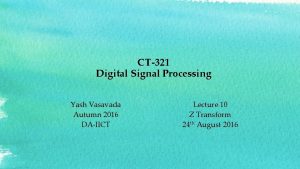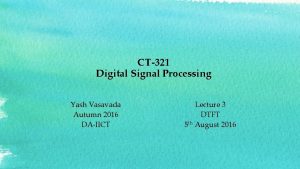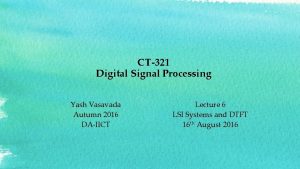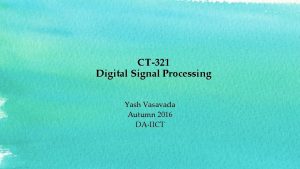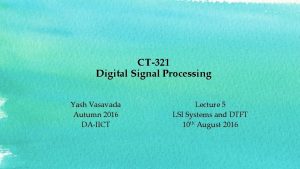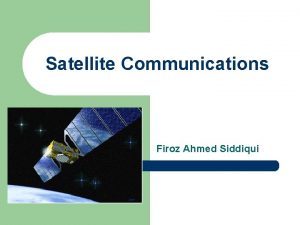CT474 Satellite Communications Yash Vasavada Autumn 2016 DAIICT
















- Slides: 16

CT-474: Satellite Communications Yash Vasavada Autumn 2016 DA-IICT Lecture 4 Power, Energy and SNR 8 th August 2016

Review and Preview ▪ Review of the prior lecture: – Power, Energy and SNR ▪ Linear and Logarithmic Units – Relationship between Information Bit Rate and Symbol Rate ▪ Channel Encoding, Modulation at SATCOM transmitter ▪ Preview of this lecture: – We will continue the topic of the tradeoff involved in selection of the key system parameters: data rate, power and bandwidth Yash Vasavada DA-IICT. Autumn 2016 CT-474. Lecture 4: 8 th August 2016. 2

Three Critical System Parameters ▪ Following are three critical parameters of any satellite communication system (in fact, any communication system) 1. Data Rate: Need is to maximize the data rate that can be delivered over the SATCOM system 2. Power 3. Bandwidth • Achieved data rate increases with power and it increases with bandwidth. In reality, both these resources are limited ▪ Data rate achieved is a function of power and bandwidth. We look at this relationship next Yash Vasavada DA-IICT. Autumn 2016 CT-474. Lecture 4: 8 th August 2016. 3

Block Diagram of Ground Segment • Attained bandwidth is determined by the design of modem ▪ Transmitted power is determined by the HPA used • Allotted bandwidth is determined by the spectrum granted by the regulatory bodies (e. g. , FCC, ITU) Signal to/from SAT Data rate is as required by the user (e. g. , a video download/upload will have a much greater data rate requirement compared to transfer of emails) Yash Vasavada DA-IICT. Autumn 2016 CT-474. Lecture 4: 8 th August 2016. 4

Amplitude, Power, and Energy ▪ Amplitude A Binary Symbol Stream Time Yash Vasavada DA-IICT. Autumn 2016 CT-474. Lecture 4: 8 th August 2016. 5

Amplitude, Power and Energy: Time versus Frequency Domain Views ▪ A rough analogy and a conceptual (mathematically inexact) visualization of the dual relationship between the power and energy in time-frequency domains Time Domain Frequency Domain ▪ Thus, two ways of measuring the quality or fidelity of the received signal compared to the noise – Ratio of power levels of signal and noise (level ratio in time domain, area ratio in frequency domain) – Ratio of energy levels of signal and noise (level ratio in frequency domain, area ratio in time domain) Yash Vasavada DA-IICT. Autumn 2016 CT-474. Lecture 4: 8 th August 2016. 6

Symbol Rate and Information (Bit) Rate ▪ A Simplified Diagram of the Transmitter of a Digital Communication System Yash Vasavada DA-IICT. Autumn 2016 CT-474. Lecture 4: 8 th August 2016. 7

Different Types of Modulation ▪ Yash Vasavada DA-IICT. Autumn 2016 CT-474. Lecture 4: 8 th August 2016. 8

Symbol Rate and Information (Bit) Rate ▪ Yash Vasavada DA-IICT. Autumn 2016 CT-474. Lecture 4: 8 th August 2016. 9

Symbol Rate and Bandwidth ▪ Time Domain Yash Vasavada Frequency Domain DA-IICT. Autumn 2016 CT-474. Lecture 4: 8 th August 2016. 10

Symbol Rate and Bandwidth ▪ Time Domain Yash Vasavada Frequency Domain DA-IICT. Autumn 2016 CT-474. Lecture 4: 8 th August 2016. 11

Signal to Noise Ratio and Bit Error Rate ▪ Filter Bandwidth B Yash Vasavada DA-IICT. Autumn 2016 CT-474. Lecture 4: 8 th August 2016. 12

Signal to Noise Ratio and Bit Error Rate ▪ Yash Vasavada DA-IICT. Autumn 2016 CT-474. Lecture 4: 8 th August 2016. 13

Signal to Noise Ratio and Bit Error Rate ▪ Yash Vasavada DA-IICT. Autumn 2016 CT-474. Lecture 4: 8 th August 2016. 14

Signal to Noise Ratio and Bit Error Rate ▪ Common Measures of Signal Quality and a Table of Conversion Among Them SNR Yash Vasavada DA-IICT. Autumn 2016 CT-474. Lecture 4: 8 th August 2016. 15

SNR in Linear and Logarithmic Scale ▪ SNR is often expressed in logarithmic (decibel) scale ▪ This chart shows the relative levels in the regular (linear) scale for different SNR values in d. B SNR = -6 d. B Yash Vasavada DA-IICT. Autumn 2016 SNR = 0 d. B CT-474. Lecture 4: 8 th August 2016. SNR = +6 d. B SNR = +12 d. B 16
